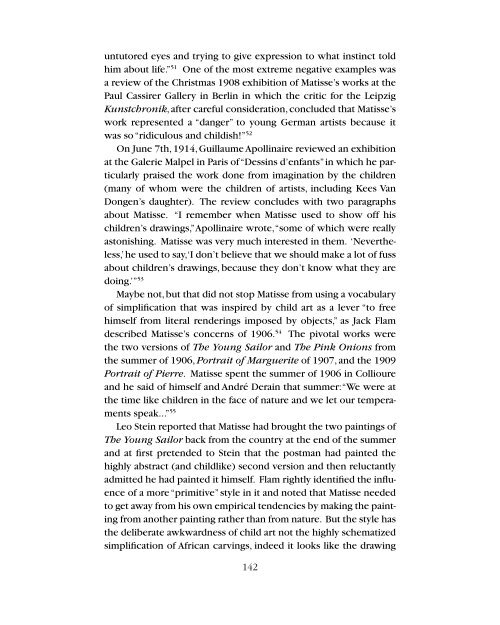Jonathan Fineberg – The Postman Did It – Children’s Art and the Avant-garde
Excerpt from “A Kid Could Do That!”, an extensive publication prepared by Galerie Gmurzynska on the occasion of the large-scale eponymous exhibition project at Art Basel Miami Beach 2014, conceived with Hollywood luminaries Baz Luhrmann and Catherine Martin.
Excerpt from “A Kid Could Do That!”, an extensive publication prepared by Galerie Gmurzynska on the occasion of the large-scale eponymous exhibition project at Art Basel Miami Beach 2014, conceived with Hollywood luminaries Baz Luhrmann and Catherine Martin.
- No tags were found...
Create successful ePaper yourself
Turn your PDF publications into a flip-book with our unique Google optimized e-Paper software.
untutored eyes <strong>and</strong> trying to give expression to what instinct told<br />
him about life.” 51 One of <strong>the</strong> most extreme negative examples was<br />
a review of <strong>the</strong> Christmas 1908 exhibition of Matisse’s works at <strong>the</strong><br />
Paul Cassirer Gallery in Berlin in which <strong>the</strong> critic for <strong>the</strong> Leipzig<br />
Kunstchronik, after careful consideration, concluded that Matisse’s<br />
work represented a “danger” to young German artists because it<br />
was so “ridiculous <strong>and</strong> childish!” 52<br />
On June 7th, 1914, Guillaume Apollinaire reviewed an exhibition<br />
at <strong>the</strong> Galerie Malpel in Paris of “Dessins d’enfants” in which he particularly<br />
praised <strong>the</strong> work done from imagination by <strong>the</strong> children<br />
(many of whom were <strong>the</strong> children of artists, including Kees Van<br />
Dongen’s daughter). The review concludes with two paragraphs<br />
about Matisse. “I remember when Matisse used to show off his<br />
children’s drawings,” Apollinaire wrote, “some of which were really<br />
astonishing. Matisse was very much interested in <strong>the</strong>m. ‘Never<strong>the</strong>less,’<br />
he used to say, ‘I don’t believe that we should make a lot of fuss<br />
about children’s drawings, because <strong>the</strong>y don’t know what <strong>the</strong>y are<br />
doing.’” 53<br />
Maybe not, but that did not stop Matisse from using a vocabulary<br />
of simplification that was inspired by child art as a lever “to free<br />
himself from literal renderings imposed by objects,” as Jack Flam<br />
described Matisse’s concerns of 1906. 54 The pivotal works were<br />
<strong>the</strong> two versions of The Young Sailor <strong>and</strong> The Pink Onions from<br />
<strong>the</strong> summer of 1906, Portrait of Marguerite of 1907, <strong>and</strong> <strong>the</strong> 1909<br />
Portrait of Pierre. Matisse spent <strong>the</strong> summer of 1906 in Collioure<br />
<strong>and</strong> he said of himself <strong>and</strong> André Derain that summer: “We were at<br />
<strong>the</strong> time like children in <strong>the</strong> face of nature <strong>and</strong> we let our temperaments<br />
speak...” 55<br />
Leo Stein reported that Matisse had brought <strong>the</strong> two paintings of<br />
The Young Sailor back from <strong>the</strong> country at <strong>the</strong> end of <strong>the</strong> summer<br />
<strong>and</strong> at first pretended to Stein that <strong>the</strong> postman had painted <strong>the</strong><br />
highly abstract (<strong>and</strong> childlike) second version <strong>and</strong> <strong>the</strong>n reluctantly<br />
admitted he had painted it himself. Flam rightly identified <strong>the</strong> influence<br />
of a more “primitive” style in it <strong>and</strong> noted that Matisse needed<br />
to get away from his own empirical tendencies by making <strong>the</strong> painting<br />
from ano<strong>the</strong>r painting ra<strong>the</strong>r than from nature. But <strong>the</strong> style has<br />
<strong>the</strong> deliberate awkwardness of child art not <strong>the</strong> highly schematized<br />
simplification of African carvings, indeed it looks like <strong>the</strong> drawing<br />
142

















